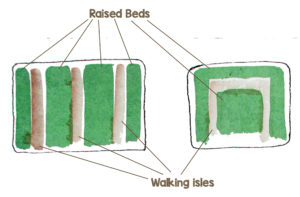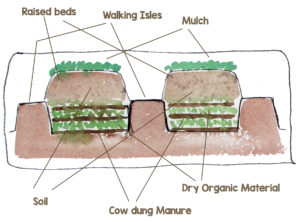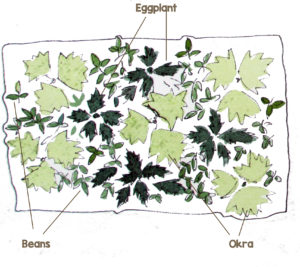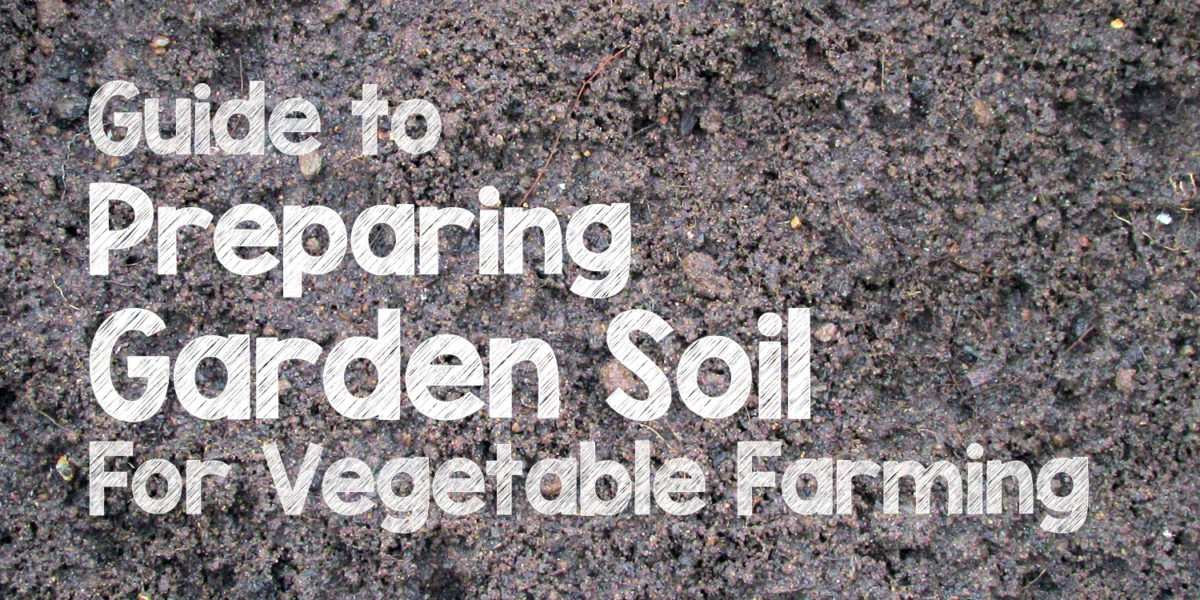Sometime back one of our readers wrote to us about his ridge gourd plant that he was growing in his backyard vegetable garden. And he wanted to know if there is any special way to prepare garden soil for farming in the backyard. I am making this post to help him out on preparing a raised bed garden. And I am sure this will be useful to many others who want grow organic vegetables in raised vegetable beds.
In organic farming and especially in natural farming as made famous by Masanobu Fukuoka we follow a ‘no till’, ‘no dig’ method of farming. The tiling and digging is all done by the microbes and other organisms living in the soil. Our job is just to make sure that they are comfortable and well fed. In this post I’ll be taking you through the steps of preparing your garden soil and maintaining it, for a ‘no-till’, ‘no-dig’ method of natural farming.
Division of Garden Space

The first and foremost task in preparing your garden soil for organic vegetable farming is to clearly divide the garden space into vegetable beds and walking aisles. Walking aisles as the name suggests are the pathways where you walk and vegetable beds are areas where you grow vegetables. Once the beds are made, you should not be walking on the raised beds as it leads to compaction of the garden soil. The garden should be designed in such a way that you should be able to access all parts of the raised garden beds from the isle. Making sure that you can access any part of the garden beds from only one point in the walking isles makes sure that area is used efficiently. Generally by extending our arms we can access upto 2 feet of a raised garden bed. If there are walking isles on both side of a garden bed then you can keep 4 feet as the width of the raised bed. If you can access the bed only from one walking isle then its width will be 2 feet. The width of the walking isle is generally kept 2 feet as it is enough for an average person to walk on and do gardening activities. But feel free to change these numbers according to your physicality.
Create a Lasagna Garden for a Head Start
Now don’t get me wrong. We don’t grow lasagna in our garden. Lasagna Garden here simply refers to the way the garden soil is prepared. It just has a good resemblance to the process of making a lasagna. Just like there are layers of veggies, meat, pasta sheets and sauce in a lasagna your garden bed is going to have layers of different types of organic materials and garden soil.

To prepare a bed first you need to dig out the soil (though this involves digging, this is a one time job only) up to 9 to 10 inches from the vegetable beds. Do not dig the walking isles. Now you need to throw in different kind of organic materials into it along with some of the soil, cow dung manure, compost, wood ash in layers. You can use any kind of organic materials. Some of them are,
- Dry brown leaves
- Dry Green leaves
- Grass clipping
- Twigs, branches of plants
- Weeds (Make sure they are not bearing seeds)
- Puja Flowers
- Coffee grounds
- Tea leaves
- Corrugated sheets
- Vegetable and Fruit Peels (Make sure they are dried up)
You need to take care that the ratio of your greens to browns is in between 1:1 to 2:1. This helps in faster and proper break down of the organic materials. If you are wondering what are greens and browns here is an excellent resource you can read up.
Here are the steps of layering the vegetable grow bed.
- Spread some cow dung manure in a thin layer.
- Spread 3-4 inches of organic material.
- Sprinkle a little amount of Amrut Jal to make the organic material slightly moist. This helps in faster decomposition. If you don’t have Amrut jal you can use plain water.
- On top of it sprinkle cow dung manure, wood ash and some soil. Manure is a source of microbes which will breakdown the organic material. Wood ash helps in bringing down the acidity of the decomposed organic material.
- Additionally you can add some neem cake for pest and disease control.
- Now go to step 2 and repeat for 3 to 4 times until the entire bed is filled up.
- Finally cover the bed with the leftover soil. You’ll end up with a garden bed which will be slightly raised w.r.t to your walking isle. By the way if your soil is really bad don’t hesitate to mix in some compost to the soil.
Building Garden Soil by Mulching
Creating a lasagna vegetable bed gives a good head star. But you’ll have to keep building the top soil all the time. Now this may sound like a huge task. But in reality you really don’t have to do much. Nature will do all the job for you. You only have to let it.
All you really have to do is mulch. Cover your vegetable beds with 4 inches of loose organic material. Grass clippings, leaves, cleaned and dried sugarcane baggasse and paddy straw are some of the things you can use. From time to time keep sprinkling Amrut Jal to supply nitrogen. The mulch serves four basic purposes.
- Protect the microbiology in the soil from direct sunlight and rain. Microbial life in the soil does not exactly like the heat of sunlight. They do much better under some shade. When you provide shade microbial life flourishes. Moreover the mulch layer will prevent evaporation and thus maintain moisture which again is essential for microbiology of the soil.
- Prevents nutrients from the soil getting oxidized and evaporated into air. Prevents leaching of nutrients due to heavy rains.
- Builds top soil through decomposition. This is also known as sheet composting or in situ composting. When you mulch with organic material its not just going to sit there quietly. The lower layer which is in touch with the soil will start decomposing and will become top soil. Giving a sprinkle of Amrut Jal time to time will make sure that the decomposition happens faster. As the mulch decomposes you need to put more organic material to keep the thickness of mulch at 4 inches. So keep checking and adding mulch time to time.
- Prevent weeds from growing in the garden soil by blocking sunlight.
Useful Tip – Weeds generally have a very deep root systems which helps them to survive. As the roots go deep they pull out lot of minerals from under the earth. Hence mulching with leaves and stems of local weeds helps a lot in soil building.
Protecting Raised Garden Beds

Soil building in your vegetable garden is a continuous activity. You need to keep the ground well mulched all the time. The waste leaves, old and dead plants come into use when your vegetable garden becomes a complete functional unit. Just chop and drop them on the raised bed and you are done. The mulch protects the soil from sunlight and rain. But when the sun is very hot or there is lashing rains you need more than just mulch to protect your garden soil. And again the solution comes from design.
If you grow plants of different height on the same bed together they can provide an added layer of protection. For example suppose you grow okra on a garden bed. Then in between the okra plants you you can grow brinjal. And then whatever gaps are left you can grow a creeper bean to cover it up. If you get a bird’s eye view of the garden bed then you should not be able to see the mulch layer through your plants. Which means that planting vegetables of different height has given an extra layer of protection to your garden soil. Another way to cover up the bed is by planting creepers with big leaves. Plant anything like a pumpkin, bottle gourd or cucumber and let is spread over the raised bed to cover it everywhere.
To make sure that the vegetable patch always remains fertile follow crop rotation on them. Rotating your crops on the same garden bed ensures that the same type of nutrient is not getting used always and your soil is not getting imbalanced.
And lastly as I pointed out in the beginning of the post you should never ever step on to the garden bed. It will compact the soil and make it hard. It will also kill a lot of microbiology in the soil. Additionally you also must check the mulch getting compacted. Sometimes when that happens anaerobic bacteria get activated as there is not enough aeration and you really don’t want that.



Sir,
Enlightened by reading your article on how to prepare garden soil. My question is can it be done with a 200 ltrs plastic drum, shall I have to make holes everywhere. I have enough of both green and brown organic matters, may I use the green matters directly or I will have to make them dry first, And how much time will be needed to get the prepared soil, if done in the said drum.
Thanks,
I will be eagerly waiting for your reply.
I guess the drum you are talking about is the one used for storing water. If you are using that and you are going to place it on your terrace or balcony I suggest you mix your own potting soil. If you make the potting mix your soil will be ready in a day. And the maintenance is also mentioned in the same post.
It will be good if you make holes all around, but its not a must. You can bury the organic material. But make sure it has been dried off.